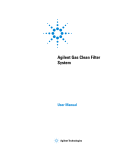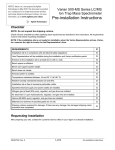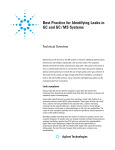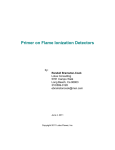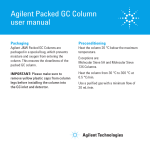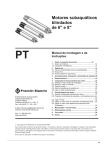Download Gas Clean Filter System User Guide
Transcript
Agilent Gas Clean Filter System User Manual Agilent Technologies Notices © Agilent Technologies, Inc. 2013 Warranty No part of this manual may be reproduced in any form or by any means (including electronic storage and retrieval or translation into a foreign language) without prior agreement and written consent from Agilent Technologies, Inc. as governed by United States and international copyright laws. The material contained in this document is provided “as is,” and is subject to being changed, without notice, in future editions. Further, to the maximum extent permitted by applicable law, Agilent disclaims all warranties, either express or implied, with regard to this manual and any information contained herein, including but not limited to the implied warranties of merchantability and fitness for a particular purpose. Agilent shall not be liable for errors or for incidental or consequential damages in connection with the furnishing, use, or performance of this document or of any information contained herein. Should Agilent and the user have a separate written agreement with warranty terms covering the material in this document that conflict with these terms, the warranty terms in the separate agreement shall control. Manual Part Number 5973-1528 Edition Third edition, August 2013 Second edition, May 2013 First edition, August 2012 Printed in USA Agilent Technologies, Inc. 2850 Centerville Road Wilmington, DE 19808-1610 USA Safety Notices CAUTION A CAUTION notice denotes a hazard. It calls attention to an operating procedure, practice, or the like that, if not correctly performed or adhered to, could result in damage to the product or loss of important data. Do not proceed beyond a CAUTION notice until the indicated conditions are fully understood and met. WA R N I N G A WARNING notice denotes a hazard. It calls attention to an operating procedure, practice, or the like that, if not correctly performed or adhered to, could result in personal injury or death. Do not proceed beyond a WARNING notice until the indicated conditions are fully understood and met. Agilent Gas Clean Filter System User Manual Using the Gas Clean Filter System About the Gas Clean Filter System 4 Components 4 Features 5 Filter types 5 Safety Information 9 General gas safety 9 Cleaning 9 Recycling the product 9 Installation 10 Before you begin 10 Prepare your instrument 10 Install the connecting unit 11 Connect the gas lines 23 Install the filter to the connecting unit 26 Install a two- or four-position connecting unit 37 Gas Flow in a Gas Clean Filter 39 Replacing the Gas Clean Filter 40 When to replace the Gas Clean Filter 40 To replace the Gas Clean Filter 42 Checking for Leaks 44 Indicator changes color from the top down 44 Indicator changes color from the bottom up 45 Replacement Parts 46 Agilent Technologies 3 Using the Gas Clean Filter System About the Gas Clean Filter System The Agilent Gas Clean Filter system delivers high purity gases to your analytical instruments, reducing the risk of column damage, sensitivity loss, and instrument downtime. The filters are designed for use with the GC, GC/MS, ICP- OES, ICP- MS, LC/MS, and any other analysis instrument using carrier gas. Six filters are available, including CO2, oxygen, moisture, and organics trap (charcoal). Components The Gas Clean Filter System consists of a connecting unit and filter (Figure 1). The connecting unit is equipped with inlet and outlet connectors for the gas lines, and two needle- like valves that automatically start the flow of gas once a filter is attached. The filters come filled with dry nitrogen and are made from a heavy- walled polycarbonate sealed at the base with PTFE. When installed onto the connecting unit, the needle- like valves puncture the PTFE seals and allow gas to flow through the filter. Connecting unit Filter Outlet connector Inlet connector Figure 1 4 The components of the Gas Clean Filter System (connecting units vary in appearance but perform the same functionality) User Guide Using the Gas Clean Filter System Features The Gas Clean Filter System delivers the following features and benefits: • Cleaner gas, longer instrument life, greater sensitivity, higher data accuracy, and overall long- term stability for your instruments and analyses. • A high- flow connecting unit that handles flow rates up to 20 L/min for collision gas applications and supply gas for ICP- MS, ICP- OES, and LC- MS. • A fast- stabilizing and absorbent filter material. • Filter housing constructed with a transparent and virtually unbreakable, heavy- walled polycarbonate material. • The ability to change the Gas Clean Filter without tools or gas shut- off. Filter types Each Gas Clean Filter type is designed to filter out a specific impurity that may exist in the gas supply. The following filter types are available: • Carbon Dioxide - Eliminates CO2 from supply gas to the Total Organic Carbon (TOC) analyzer, and improves sensitivity and accuracy in TOC analysis. • Oxygen - Prevents oxidation of the GC column, septum, liner, and glass wool. • Moisture - Delivers faster stabilization times for increased GC productivity, and prevents hydrolization damage to the stationary phase, column, liner, glass wool, or septum in the GC. • Process Moisture - Prevents oxidation of GC components and is safe to use with acetylene in process GC applications. • Charcoal - Removes organic compounds and ensures correct performance of FID detectors in the GC. • GC/MS - Delivers faster stabilization times for increased GC productivity, removes oxygen, moisture, and hydrocarbons from the carrier gas for MS applications, and provides ultimate GC column protection. Table 1 on page 6 shows recommended filter connection diagrams for common instrument configurations. User Guide 5 Using the Gas Clean Filter System Table 1 Connection diagrams for common detectors Detector ECD Electron Capture Detector Connection Diagram Carrier Gas Oxygen Filter Moisture Filter Nitrogen Oxygen Filter Moisture Filter Column Make-Up Gas Anode Purge Gas ECD FID Carrier Gas Oxygen Filter Hydrogen Charcoal Filter Air Charcoal Filter Carrier Gas GC/MS Filter Make-Up Gas Charcoal Filter Hydrogen Charcoal Filter Moisture Filter Column Flame Ionization Detector (Carrier Gas = Make-Up Gas) FID FID Column Flame Ionization Detector (Carrier Gas differs from Make-Up Gas) FID FPD Air Charcoal Filter Carrier Gas Oxygen Filter Hydrogen Charcoal Filter Moisture Filter Column Flame Photometric Detector PFPD Pulsed Flame Photometric Detector Air Flame 1 Charcoal Filter FPD Flame 2 6 User Guide Using the Gas Clean Filter System Table 1 Connection diagrams for common detectors (continued) Detector MS (ITD, MSD) Connection Diagram Carrier Gas GC/MS Filter Column Ion Trap Detector, Mass Selective Detector MS Carrier Gas Oxygen Filter Moisture Filter Column MS NPD, PND Carrier Gas Oxygen Filter Moisture Filter Column Nitrogen-Phosphorous Detector Make-Up Gas TID, TSD Hydrogen Charcoal Filter Air Charcoal Filter Carrier Gas Oxygen Filter Thermionic Detector (Carrier Gas = Make-Up Gas) TCD TSD Moisture Filter Column Thermal Conductivity Detector Reference Channel Make-Up Gas, if necessary User Guide TCD 7 Using the Gas Clean Filter System Table 1 Connection diagrams for common detectors (continued) Detector Connection Diagram ICP-OES/ICP-MS Oxygen Filter Inductive Coupled Plasma-Optical Emission Spectrometry/-Mass Spectrometry Supply Gas Oxygen Filter ICP-MS ICP-OES (Plasma Gas = Nebulizer Gas) ICP-OES Inductive Coupled Plasma-Optical Emission Oxygen Filter Supply Gas ICP-OES Oxygen Filter (Different Optic Flush Gas) High-Flow Base Plate Optic Flush Gas Total Organic Carbon (TOC) Analyzer Zero-Air Generator Oxygen Filter Carrier Gas CO2 Filter Moisture Filter TOC Analyzer Carrier Gas CO2 Filter Moisture Filter Zero-Air Generator LC/MS Moisture Filter Mass Spectrometry LC/MS Supply Gas Moisture Filter High-Flow Base Plate Contact your local Agilent sales representative for the filter sets applicable to your instrument configuration. 8 User Guide Using the Gas Clean Filter System Safety Information General gas safety • Wear eye protection when using compressed gas to avoid eye injury. • Fasten all compressed gas cylinders securely to an immovable structure or permanent wall. • Store and handle compressed gases in accordance with relevant safety codes. • Do not put gas cylinders in the path of a hot air vent (including a GC oven exhaust). • Perform periodic leak checks on supply lines, fittings, and pneumatic plumbing to prevent a potentially hazardous condition. Cleaning Wipe away dust and residue using a lint- free cloth. Once the filter is consumed, the filter and filter material cannot be replenished or reused. Recycling the product When filters are replaced, they must be treated as chemical waste and disposed of according to local policy. User Guide 9 Using the Gas Clean Filter System Installation Before you begin Be sure to choose a centralized installation location where all instruments are easily reachable and where the filter’s indicating material is always visible. Gas Clean Filter connecting units are available for both 1/4- inch and 1/8- inch gas lines. Be sure you have selected the appropriate connecting unit to use with your lab setup. Prepare your instrument Prepare your instrument by doing the following: 1 Lower any heated zone temperatures on your instrument to less than 100 °C. 2 Set any purge flows on your instrument to 400 mL/min. 3 If your system pressure is higher than 7 bar (100 psi), reduce the pressure. 10 User Guide Using the Gas Clean Filter System Install the connecting unit The connecting unit can be mounted on a laboratory bench top, affixed to the wall (with optional wall- mounting bracket for the single filter connecting unit), or mounted to the back of a 7890 GC (with the Gas Clean Carrier Gas Kit for 7890). • If you wish to install your connecting until to a laboratory bench top, see “Installing on a laboratory bench top” below. • If you wish to install your connecting unit to a wall, skip to “Installing on a wall” on page 13. • If you have the Gas Clean Carrier Gas Kit for 7890 (CP17988) and wish to install the connecting unit to the back of a 7890 GC, skip to “Installing the Gas Clean Carrier Gas Kit for 7890” on page 20. Installing on a laboratory bench top You can install the connecting unit onto the laboratory bench top using two screws (not supplied). Gather the following: • Screws (2), at least 25 mm long and less than 5- mm od (not supplied) • Screw driver or power drill User Guide 11 Using the Gas Clean Filter System To install the connecting unit to the laboratory bench top: 1 Remove the two black plastic caps by pushing a thin, narrow object (such as a paper clip) from the bottom of the connecting unit into the underside of the caps until they pop out (Figure 2). Figure 2 Removing the plastic caps from the connecting unit 2 Determine the best location on your laboratory bench top to install the connecting unit and filter. • Make sure the filter’s indicator is clearly visible so that exhausted filters can be easily identified. • Make sure you have ample space above the bench top and connecting unit for installation and removal of the filter. • Make sure the gas lines reach the location and will not interfere with other activities in the chosen installation location. • Check that the mounting screws will not penetrate any dangerous objects such as gas and power lines. 3 Place the connecting unit in the chosen location, and use a screw driver or power drill to install the screws into the bench top through the two openings on the top of the connecting unit. 4 Replace the black plastic caps on the connecting unit to cover the two screw hole openings. 12 User Guide Using the Gas Clean Filter System Installing on a wall This option is only available for a single filter connecting unit using the optional wall mounting bracket. Gather the following: • Wall mounting bracket kit (CP7981) • Flathead screw driver • Hex wrench (4 mm) • Power drill with 5- mm od drill bit • Pencil To install the wall mounting bracket: 1 Determine the location on the wall where you wish to install the wall mounting bracket. • Make sure you have ample space above the mounting bracket with connecting unit installed for installation/removal of the filter. • Make sure the gas lines reach the location and will not interfere with other activities in the chosen installation location. • Check that the mounting screws will not penetrate any dangerous objects such as gas and power lines once installed. User Guide 13 Using the Gas Clean Filter System 2 Hold the wall mounting bracket against the wall in the location that you plan to install it, and use a pencil to mark the drilling location for the screw holes (Figure 3). Figure 3 Mark the drilling locations on the wall using the screw holes in the wall mounting bracket as a guide Lay the mounting bracket down on a flat surface. 3 Using a power drill with a 5- mm od drill bit, drill about 5 cm into the wall in both locations. Wipe away any excess dust and residue. 4 If required, install the supplied drywall anchors into the drilled holes, and make sure each anchor is flush against the wall’s edge (Figure 4). Figure 4 14 Plastic drywall anchors installed in wall User Guide Using the Gas Clean Filter System 5 Hold the wall mounting bracket in place against the wall using one hand, then use your other hand to install each screw into the wall (or drywall anchor, Figure 5). Finger tighten the screws as far as possible, and then use a screwdriver to complete the screw installation. The wall mounting bracket should rest flush against the wall. Figure 5 User Guide Installing the wall mounting bracket 15 Using the Gas Clean Filter System 6 The connecting unit supports gas connections on the base plate edge for surface mounting and from below when mounting the connecting unit against a wall. The connecting unit ships from the factory with the gas connections installed on the edge. In this step, the standard connecting unit is shown. Steps are similar for all connecting unit types. You can optionally change the gas inlet- outlet locations to the bottom of the connecting unit as follows: a Using a 5- mm hex wrench, remove the two plugs on the underside of the connecting unit (Figure 6). Outlet fitting Inlet fitting Plugs Figure 6 16 Plugs and inlet/outlet fittings on the connecting unit User Guide Using the Gas Clean Filter System b Using a 1/2- inch wrench, remove the inlet and outlet fittings on the end of the connecting unit (Figure 6). c Install the plugs on the end of the connecting unit using a 5- mm hex wrench (Figure 7). Plugs Figure 7 User Guide Plugs installed on the end of the connecting unit 17 Using the Gas Clean Filter System d Install the inlet and outlet fittings on the underside of the connecting unit using a 1/2- inch wrench (Figure 8). Outlet fitting Figure 8 18 Inlet fitting Inlet and outlet fittings installed on the underside of the connecting unit User Guide Using the Gas Clean Filter System 7 Install the connecting unit to the wall mounting bracket. a Depending on the inlet/outlet fitting orientation on the connecting unit, align the connecting unit to the bracket as shown in Figure 9. Figure 9 Connecting unit orientations on wall mounting bracket b Using your hand, install the hex screws from the bottom- up until they are finger tight (Figure 10). Figure 10 Hex screws installed c Use a 4- mm hex wrench to tighten the screws. The connecting unit should be tight against the wall mounting bracket. User Guide 19 Using the Gas Clean Filter System Installing the Gas Clean Carrier Gas Kit for 7890 Gather the following: • T- 10 Torx driver • T- 20 Torx driver • Gas Clean Carrier Gas Kit for 7890 (CP17988) To install the bracket and bracket connecting unit to the back of a 7890 GC: 1 Place the bracket (5003- 1356) against the back of the 7890 GC in the location shown in Figure 11, then align the screw holes as shown in Figure 12. Figure 11 Location on back of 7890 GC to install bracket Bracket Screw holes Figure 12 Screw hole locations on back of 7890 GC and bracket 20 User Guide Using the Gas Clean Filter System 2 Using a T- 10 Torx driver, install the four T- 10 screws to secure the bracket to the GC. See Figure 13. Figure 13 Bracket 5003-1356 installed to 7890 GC 3 If you wish to run the inlet and outlet plugs from the bottom of the bracket connecting unit, see step 6 on page 16 before installing the bracket connecting unit to the bracket. User Guide 21 Using the Gas Clean Filter System 4 Install the bracket connecting unit to the bracket using the supplied T- 20 Torx screws. • If you have an ALS installed with your system, install the bracket connecting unit to the top of the bracket (Figure 14). Figure 14 Bracket connecting unit installed on the bracket top for ALS and general configurations • If you have a PAL Auto Sampler installed with your system, install the bracket connecting unit to the underside of the bracket (Figure 15). Figure 15 Bracket connecting unit installed on underside of bracket for PAL Auto Sampler configuration 22 User Guide Using the Gas Clean Filter System Connect the gas lines Before starting, make sure you have enough gas line tubing to reach the area where you wish to mount the Gas Clean Filter system. For best results, use pre- cleaned gas lines. Gather the following: • Swagelok nuts (included with the connecting unit assembly) • Front and back ferrules (included with the connecting unit assembly) • Wrench, 7/16- inch (for 1/8- inch nuts) or 9/16- inch (for 1/4- inch nuts) • Pre- cleaned tubing • Ball valve (0100- 2144), required for the Gas Clean Carrier Gas Kit for 7890 (CP17988) • Electronic leak detector, such as the Agilent G3388B Handheld Electronic Gas Leak Detector To connect the gas lines to the connecting unit: 1 Place a Swagelok nut, back ferrule, and front ferrule to the tubing as shown in Figure 16. Front ferrule Back ferrule Nut Important! The narrow end of the back ferrule fits into the rear of the front ferrule. Tubing Figure 16 Swagelok nuts and ferrules User Guide 23 Using the Gas Clean Filter System 2 Push the tubing towards the base until it rests firmly against the shoulder in the fitting, and make sure that the front ferrule is touching the fitting. Slide the Swagelok nut over the ferrule and thread it onto the fitting (Figure 17). Nut and ferrules Fitting Tubing Figure 17 Assemble the fitting 3 Push the tube fully into the fitting, then withdraw it approximately 1 to 2 mm (see Figure 18). Front ferrule Nut Insert tubing fully Back ferrule Withdraw tubing 1-2 mm Tighten nut Figure 18 Insert the tubing 4 Finger- tighten the nut. Then use a wrench to tighten the nut 3/4 turn (for 1/8- inch tubing). 24 User Guide Using the Gas Clean Filter System 5 If you have the Gas Clean Carrier Gas Kit for 7890 (CP17988), install a ball valve immediately following the outlet connection on the bracket connecting unit as shown in Figure 19. Outlet Ball valve Bracket connecting unit Figure 19 Ball valve installed following the outlet connection on the bracket connecting unit A ball valve installation is optional for standard connecting units. 6 Set the gas line pressure to a value between 2 bar (30 psi) and 4 bar (60 psi) when installing the filter to the connecting unit. Be sure to keep the pressure above 2 bar (30 psi) so that air does not enter the filter. 7 Check all connections for leaks using the leak detector. User Guide 25 Using the Gas Clean Filter System Install the filter to the connecting unit CAUTION Wear clean, lint-free gloves to prevent contamination of parts with dirt and skin oils. If you have the Gas Clean Carrier Gas Kit for 7890, skip to “Bracket connecting unit” on page 31. Standard connecting units To install the filter on a standard connecting unit: 1 Unscrew the knurled ring and remove the red plastic dust cap from the top of the connecting unit (Figure 20). Red plastic dust cap Knurled ring Figure 20 Remove the red plastic dust cap 26 User Guide Using the Gas Clean Filter System 2 Flush the gas line of oxygen and moisture. If available, use the optional flush head (part number CP7987) to flush the gas line (Figure 21). Place the flush head over the valves and alignment pin and push down until it rests on the base of the connecting unit. Install the knurled ring to hold it in place. Flush head Figure 21 Using the flush head to flush the gas line of oxygen and moisture User Guide 27 Using the Gas Clean Filter System If you do not have the flush head, use a small object or your finger to depress the inlet valve. (The inlet valve has an O- ring positioned at the top of the cylinder, as shown in Figure 22.) O-ring O-ring Inlet valve Outlet valve Figure 22 Depress the inlet valve to flush the gas line of oxygen and moisture Flush the gas lines for at least several minutes to ensure the gas lines are free of oxygen and moisture. 28 User Guide Using the Gas Clean Filter System 3 Remove the filter from the packaging, then remove the two aluminum plugs from the bottom of the filter (Figure 23). Aluminum plugs Figure 23 Remove the aluminum plugs from the filter 4 Place the knurled ring over the filter, then place the filter on top of the connecting unit (it will only fit one way due to the alignment pin shown in Figure 24). Be careful to not damage the connecting unit and filter components by forcing an incorrect filter orientation. Alignment pin Figure 24 Alignment pin User Guide 29 Using the Gas Clean Filter System 5 Tighten the knurled ring while gently pressing down on the filter. Let the knurled ring pull the filter onto the connecting unit as it is tightened (Figure 25). Knurled ring Figure 25 Tighten the knurled ring to secure the filter to the connecting unit 6 Allow the filter to pressurize for 3 minutes. 7 Flush the filter. Set the instrument split vent flow (purge flow) to 400 mL/min, then: • If using a Moisture Filter in combination with an MS detector, purge the filter for at least 60 minutes. This will flush the filter of dry nitrogen so that it does not appear as a background ion in your MS analysis. • For all other filter and detector combinations, purge for 4 minutes. 8 Restore to normal operating supply pressure and method settings. (Remember to keep at a minimum supply pressure of 2 bar (30 psi).) 30 User Guide Using the Gas Clean Filter System Bracket connecting unit To install the GC/MS filter on the Gas Clean Carrier Gas Kit for 7890 bracket connecting unit: 1 Turn the ball valve to the on position. 2 Unscrew and remove the plastic ring nut from the top of the bracket connecting unit (Figure 26). Plastic ring nut Bracket connecting unit Figure 26 Remove the plastic ring nut from the bracket connecting unit User Guide 31 Using the Gas Clean Filter System 3 Flush the gas line of oxygen and moisture. If available, use the optional flush head (part number CP7987) to flush the gas line (Figure 27). Place the flush head over the valves and alignment pin and push down until it rests on the base of the connecting unit. Install the knurled ring to hold it in place. Flush head Ball valve on Figure 27 Using the flush head to flush the gas line of oxygen and moisture 32 User Guide Using the Gas Clean Filter System If you do not have the flush head, use a small object or your finger to depress the inlet valve. (The inlet valve has an O- ring positioned at the top of the cylinder, as shown in Figure 28.) O-ring O-ring Inlet valve Outlet valve Figure 28 Depress the inlet valve to flush the gas line of oxygen and moisture Flush the gas lines for at least several minutes to ensure the gas lines are free of oxygen and moisture. User Guide 33 Using the Gas Clean Filter System 4 Remove the GC/MS filter from the packaging, then remove the two aluminum plugs from the bottom of the filter (Figure 29). Aluminum plugs Figure 29 Remove the aluminum plugs from the GC/MS filter 5 Place the plastic ring nut over the GC/MS filter, then place the filter on top of the bracket connecting unit (it will only fit one way due to the alignment pin shown in Figure 30). Be careful to not damage the bracket connecting unit and filter components by forcing an incorrect filter orientation. Alignment pin Figure 30 Alignment pin 34 User Guide Using the Gas Clean Filter System 6 Tighten the plastic ring nut while gently pressing down on the filter. Let the plastic ring nut pull the GC/MS filter onto the bracket connecting unit as it is tightened (Figure 31). Figure 31 GC/MS filter installed to the bracket connecting unit User Guide 35 Using the Gas Clean Filter System 7 Allow the GC/MS filter to pressurize for 3 minutes. 8 Flush the filter. Set the instrument split vent flow (purge flow) to 400 mL/min, then: • If using a Moisture Filter in combination with an MS detector, purge the filter for at least 60 minutes. This will flush the filter of dry nitrogen so that it does not appear as a background ion in your MS analysis. • For all other filter and detector combinations, purge for 4 minutes. 9 Restore to normal operating supply pressure and method settings. (Remember to keep at a minimum supply pressure of 2 bar (30 psi).) 36 User Guide Using the Gas Clean Filter System Install a two- or four-position connecting unit The steps for installing a two- or four- position connecting unit are similar to the steps for the single- filter connecting unit. Refer to the previous sections in this chapter for details (“Installation” on page 10). Two-position connecting unit When installing the two- position connecting unit, refer to Figure 32 for gas line and filter installation locations. Oxygen Moisture Figure 32 Two-position connecting unit User Guide 37 Using the Gas Clean Filter System Four-position connecting unit When installing the four- position connecting unit, refer to Figure 33 and Figure 34 for common gas line and filter configurations. Instrument Air In Out Charcoal Carrier Gas In Oxygen Carrier Gas Out Moisture Hydrogen In Out Charcoal Figure 33 Configuration 1: Four-position connecting unit Instrument Air In Out Carrier Gas In Out Hydrogen In Out Makeup Gas In Out Charcoal GC/MS Charcoal Charcoal Figure 34 Configuration 2: Four-position connecting unit 38 User Guide Using the Gas Clean Filter System Gas Flow in a Gas Clean Filter Gas flows in an upward direction from the bottom of the filter to the top, and then downward through the filter material, indicating material, and out the bottom of the filter (see Figure 35). Filter material Indicating material Figure 35 Flow of gas through the Gas Clean Filter User Guide 39 Using the Gas Clean Filter System Replacing the Gas Clean Filter When to replace the Gas Clean Filter As gas passes through the filter material, the filter picks up impurities and eventually becomes consumed over time. When this occurs, an increased amount of impurities reach the indicating material, which causes the material to change color from the top- down. When 75% or more of the indicating material’s color has changed, this indicates that the filter is consumed (see Figure 36). Filter material Indicating material color change Indicating material original color Figure 36 Indicating material color change Agilent recommends replacing the filter when 75% or more of the indicator’s color has changed (from the top down) or within one year of installation. 40 User Guide Using the Gas Clean Filter System The indicator color and consumed indicator colors are different for each type of filter. See Table 2 for a description of each filter indicator color and consumed color change. Table 2 Indicating material color description Filter type Original color Consumed color Oxygen Filter Green Gray Moisture Filter/ Process Moisture Filter Green Pale brown Charcoal Filter No indicator No indicator GC/MS Filter Oxygen: Green Moisture: Green Gray Pale brown CO2 Filter White Violet See “To replace the Gas Clean Filter” on page 42 for more information. User Guide 41 Using the Gas Clean Filter System To replace the Gas Clean Filter This procedure shows the standard connecting unit in the examples. Steps are similar for all connecting unit types. To replace the Gas Clean Filter: 1 Lower any heated zone temperatures on your instrument to less than 100 °C. 2 Set any split vent flows (purge flows) on your instrument to 400 mL/min. 3 If your system pressure is higher than 7 bar (100 psi), reduce the pressure to a pressure no lower than 2 bar (30 psi) to ensure easy removal of the saturated filter. 4 Remove the saturated filter by unscrewing the knurled or plastic ring nut that secures the filter to the connecting unit (Figure 35). Figure 37 Unscrew the knurled or plastic ring nut 5 Remove the new filter and O- rings from the packaging. 42 User Guide Using the Gas Clean Filter System 6 Remove the old upper set of O- rings using the supplied tool and replace with new O- rings (Figure 38). Figure 38 Remove upper pair O-rings only when replacing filter 7 Remove the two aluminum plugs from the bottom of the new filter (Figure 39). Figure 39 Aluminum plugs removed from bottom of the new filter 8 Place the knurled or plastic ring nut over the filter, then put the filter on top of the connecting unit (it will only fit one way due to the alignment pin). 9 Tighten the knurled or plastic ring nut while gently pressing down on the filter; let the ring pull the filter onto the connecting unit. 10 Carefully check the connections for leaks. See “Checking for Leaks” on page 44 for more information. Treat used filters as chemical waste and dispose of them according to local policy. User Guide 43 Using the Gas Clean Filter System Checking for Leaks During leak- free operation, the filter indicator should not change color for several months, depending on the quality of your gas. If you notice a color change in your filter’s indicating material immediately following installation, this indicates a gas leak in your system, or poor gas quality. Take note whether the color change occurred from the top down or from the bottom up, and refer to one of the following sections: • “Indicator changes color from the top down” on page 44 • “Indicator changes color from the bottom up” on page 45 Indicator changes color from the top down If the indicating material changed color from the top down (see Figure 40), there is a leak upstream of the filter in your gas line, or your gas quality is poor. Check for leaks at the cylinder, regulator, and fittings, and check your gas quality. Filter material Indicating material color change Indicating material original color Figure 40 Indicating a leak upstream from the filter CAUTION 44 When about 75% of the indicator changes color from the top down, this indicates that the entire filter is consumed and needs to be replaced. User Guide Using the Gas Clean Filter System Indicator changes color from the bottom up If your filter’s indicator changes color from the bottom up shortly after installation (see Figure 41), this indicates a leak downstream of the filter in your gas line. Check for leaks between the filter and your instrument. Filter material Indicating material original color Indicating material color change Figure 41 Indicating a leak downstream from the filter If the entire indicator has not changed color (from the bottom up), the filter is not consumed and is still usable (see Figure 41). User Guide 45 Using the Gas Clean Filter System Replacement Parts Table 3 46 Agilent Gas Clean Filter Starter Kits Description Part No. Gas Clean Carrier Gas Kit for 7890 Includes GC/MS filter (CP17973), a 7890 GC mounting bracket, and a single bracket connecting unit CP17988 Agilent Gas Clean FID Filter kit Includes a 4-position 1/8 in connecting unit and two Charcoal filters, one Oxygen filter, and one Moisture filter CP7995 Gas Clean Filter Kit, 1/8 in Includes a 4-position 1/4 in connecting unit and two Charcoal filters, one Oxygen filter, and one Moisture filter CP736530 Agilent Gas Clean GC/MS Filter kit, 1/8 in Includes a 1-position connecting unit 1/8 in and two GC/MS filters CP17976 Agilent Gas Clean GC/MS Filter kit, 1/4 in Includes a 1-position connecting unit 1/4 in and two GC/MS filters CP17977 Agilent Gas Clean GC/MS Filter Installation kit Includes 1 m copper tubing (CP17976), two nuts and two ferrules, 1/8 in CP17978 Agilent Gas Clean CO2 kit Includes 2-position 1/4 in connecting unit and CO2 and moisture filters CP17982 Agilent Gas Clean CO2 kit Includes 2-position 1/8 in connecting unit and CO2 and moisture filters CP17983 TCD Filter Kit Includes a 2-position 1/8 in connecting unit, one Oxygen filter, and one Moisture filter CP738408 GC Installation Kit Includes CP736530 and many useful fittings and accessories 19199N User Guide Using the Gas Clean Filter System Table 4 Description Part No. 1-position connecting unit, 1/4 in CP7980 1-position connecting unit, 1/8 in CP7988 2-position connecting unit, 1/4 in CP738406 2-position connecting unit, 1/8 in CP738407 4-position connecting unit, 1/4 in CP7989 4-position connecting unit, 1/8 in CP736520 High flow connecting unit, 1/4 in CP17984 High flow connecting unit 1/8 in CP17985 1-position stainless steel connecting unit, 1/4 in CP7980P4 1-position stainless steel connecting unit, 1/8 in CP7988P8 1-position stainless steel connecting unit, 3 mm CP7988P3 1-position stainless steel connecting unit, 6 mm CP7980P6 1-position 7890 GC bracket connecting unit (for bracket 5003-1356) CP742950 Table 5 User Guide Connecting Units Replacement Gas Clean Filters Gas Clean Filters Part No. Agilent Gas Clean CO2 Filter CP17969 Agilent Gas Clean Oxygen Filter CP17970 Agilent Gas Clean Moisture Filter CP17971 Agilent Gas Clean Process Moisture Filter CP17971P Agilent Gas Clean Charcoal Filter CP17972 Agilent Gas Clean Filter GC-MS CP17973 47 Using the Gas Clean Filter System Table 6 48 Accessories and Fittings Gas Clean Filters Part No. Wall mounting bracket for connecting units CP7980 and CP7988 CP7981 7890 GC mounting bracket for bracket connecting unit (CP742950) 5003-1356 Ring nut connecting unit 5043-0403 Flush head for connecting unit CP7987 Male connector, 1/4 in with dust filter CP7986 Male connector, 1/8 in.with dust filter CP82117 O-rings, two sets CP7983 Male connector, stainless steel, 1/4 in with dust filter CP7986SS Male connector, stainless steel, 1/8 in with dust filter CP82117SS Male connector, stainless steel, 3 mm with dust filter CP82117SS3 Male connector, stainless steel, 6 mm with dust filter CP7986SS6 User Guide Agilent Technologies © Agilent Technologies, Inc. 2013 *5973-1528* 5973-1528


















































